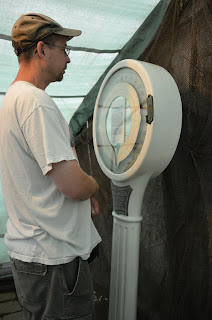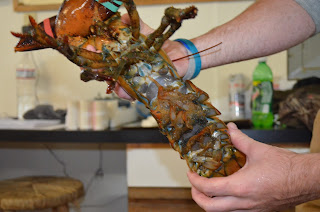Up first was the hands on activities where the boys explore a touch and guess barrel and each took turns finding out what they weighed under water.
I REFUSED to step on the scales, even if it would present with a LOWER number.
We were scheduled for the Lobster Hatchery after that and made our way into a room full of tubes, buckets and several circles of cut pvc piping. I honestly had no awareness of the life cycle of a lobster and I am not a fan of eating them either, but I learned some very interesting facts about LOBSTERS!
FACTS ABOUT LOBSTERS:
1.There is only one remaining Lobster Hatchery in Maine and this is it. The government has pulled its funding and raising Lobster is more difficult then it seems.
2. It is illegal to retain a mother (pregnant) Lobster and any caught must be returned to the ocean.
3.It takes 2 years to produce baby lobsters and they are so small they are easily eaten by predators and the even eat each other.
4. Lobsters take about seven years to reach a weight large enough to be caught and sold for the dinner plate.
5. Lobsters over a certain weight (I cannot remember but over 27 pounds) can only be tagged and returned to the ocean.
6. Small but not infant lobsters must be separated (the reason for the pvc piping) as they do not get along with their siblings.
7. Only a small percentage of baby lobsters survive into adulthood.
8. The price of lobster is never consistent due to the inconsistency of the catch.
The stages of a baby lobster. (above) a Momma lobster with larva on her underside
Here is a better picture of her eggs (located about a fingernail up from this hatcher's thumb is the small blackish grey eggs) She has already released several at this point.
Once they are released they will eat anything that swims near their tiny mouths including each other. The hatchery keeps these little guys in constant motion to avoid such interactions, but must feed them and will also enter freeze dried shrimp (Sea Monkey's for those of us who remember ordering them from the back of comic books).
Here is a picture of the baby lobster as they work towards growing to a size appropriate for release.
They are each put into their own Lobster apartment (the pvc hotels) until they are ready for release. Pictured below. The release process is also more timely then just dumping them into the ocean, they are placed into piping that is intermitted along the bottom of the ocean floor as to prevent predators from having their own personal buffet, as well as protecting them from one another.
They showed us an underwater video of how these little guys are released in small numbers along the waters floor.
I was very intrigued by the whole process. Up next was the information about Lobster boating/catching.
This older gentleman, a former Lobster fishermen told us all about catching/releasing and eating lobster. We each got a lobster claw rubber band as a souvenir.
Gavin, sitting on a lobster trap rocker (a chair made from traps) gets to touch a lobster. This guy went on and on and although his stories were all very interesting, we were missing our time at the touch pool, and had to cut out before he was done talking. Quite an interesting fella, he told some tasteless jokes, that despite it's racism the boys could not stop joking about later. What does a lobster and a Japanese man run over by a truck have in common? They are both Crustacean's. Awful isn't it! Despite his lack of being politically correct he was an interesting guy with lots of facts about the Lobster business.
Next was the touch tank and were we (at least I was) in for some interesting facts about sea life. First to be shown and discussed was the Sea Cucumber. What an unusual looking creature. He?she? It looked more like he was straight out of the movie Aliens. EEEW!!! He was strange looking and felt even stranger!
The sea star. Which I always thought was a starfish was discussed and learned that they have little suction cups on their underside that helps them to find and hold tightly to their food. Apparently they will grab onto a mean and suck the food up into their mouths. here Gavin is getting to feel the sea stars suctions as it grabs hold to the hairs on his arm.
The sea urchin is a relative to the sea star and when placed in the water you can see his star legs emerge.
See his five legs? These guys also eat like the sea star and will suck their food up from a mouth located underneath them.
This mussel will actually throw his guts up around himself to protect him from being eaten. His slimy body till prevent predators from being able to eat him.
There was so much more weird facts about these guys, but we had to go as the next group came in. Plus we were all getting hungry and tired. I really enjoyed myself at this place and recommend it if your into the facts about sea animals.
After the Oceanarium we made one last trip into Bar Harbor and had lunch at Blaze. (the second restaurant on this trip that I did not like and also the second most expensive). Mark had a steak pizza (which wasn't to bad) Ben had a very expensive lobster roll that he couldn't finish, and Gavin and I had burgers. Not impressed.
We called it an early day and spent the rest of the evening at the hotel having decided that a boat ride was to much. Next time perhaps. We have a big drive back tomorrow, so early bedtime!

























This article is very good. check for Lobsters Facts, Diet, Behaviour, Habitat, Images, Pictures & Photos
ReplyDelete